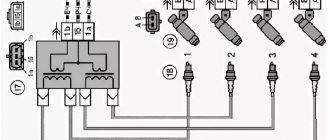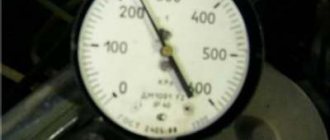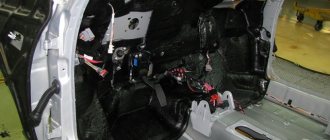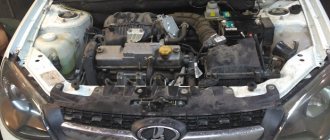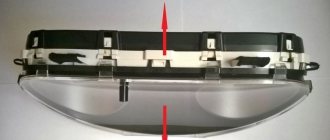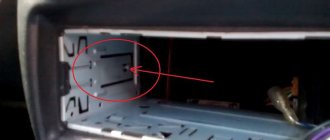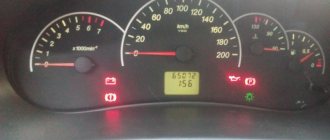The production of the popular domestic Lada Granta started in 2011. It was this car that became the next after the Lada Kalina, meeting the new needs of modern drivers. However, the value of the parameter on which the vehicle’s efficiency depends—the Lada Grant’s fuel consumption—remains always relevant. The design features of the engine and fuel system of a car determine the dependence of gasoline consumption on many factors, such as fuel quality, wear of engine parts, quality of lubricants, etc.
A competitive car in an affordable price category is available in several trim levels: Luxury, Standard and Normal. AvtoVAZ often installs an automatic transmission on Grant cars, and some modifications are equipped with a 16-valve engine instead of the standard 8-valve.
Types of system
The fuel injection system gets its name from the device that is responsible for spraying gasoline - the injector (from the English Injection - injection, injector - nozzle). A power system of this type was installed on aircraft back in the 20s of the last century. What is noteworthy is that even then it was direct fuel injection into the engine cylinders. We will focus on the development of variations of the Motronic system, in which the engine control unit (hereinafter referred to as the ECU or ECU) is responsible for supplying fuel and adjusting the ignition angle.
The main reasons causing excessive fuel consumption of Lada Granta
Among the reasons why the fuel consumption of a Lada Granta car is unreasonably high are:
- subjective, depending on driving style;
- objective, related to the features and technical condition of the machine.
In the first case, excessive consumption of gasoline is caused by:
- sudden braking and acceleration;
- poorly warmed up engine;
- ill-conceived tuning that worsens the aerodynamics of the car;
- machine overload;
- operating a vehicle in mountainous areas;
- driving too fast.
Engine LADA GRANTA
Among the objective reasons are:
- wear of engine parts;
- breakdowns or failure of elements of the vehicle’s power system;
- insufficient tire pressure;
- Brake failure, creating excessive friction and resistance.
- air conditioning operation;
- damage to the wheel bearing, causing increased resistance when driving.
Single Point fuel injection
Single-point injection, better known as mono-injection, is a transition technology that has allowed many automakers to cheaply switch from a carbureted power system to fuel injection.
In other words, instead of a carburetor, a central fuel injection unit began to be installed above the intake manifold. The system had a number of advantages, since the ECU made it possible to dose gasoline more accurately.
The operating principle of the injector is based on the following elements:
- – a fuel tank with a fuel pump located in it;
- – filter element for fuel purification;
- – central injection unit. 3a – throttle position sensor (TPS); 3b – regulator responsible for fuel pressure; 3с – injector nozzle; 3d – sensor of air temperature entering the intake manifold; 3e – throttle position regulator (in the simplest design options, the damper drive was connected to the accelerator pedal by a cable drive);
- – coolant temperature sensor (DTOZH);
- – lambda probe (oxygen sensor);
- – electronic engine control unit.
Principle of operation
The diagram does not show one element, without which the operation of the mechanism would be impossible - the crankshaft position sensor. It is the DPKV that allows the ECU to calculate the amount of air entering the engine. Let us recall that the amount of fuel supplied depends entirely on the mass of air entering the cylinders, otherwise it is impossible to regulate the composition of the air-fuel mixture (AFM) for normal operation of a gasoline engine. At the stage of engine creation, designers calculate how much air flows at a certain load, that is, the degree of throttle opening, and at certain engine speeds. The data is entered into the engine fuel map, which will be recorded in the ECU. Subsequently, when the engine is running, the control unit records the speed using the DPKV, the load is determined by the throttle potentiometer, which allows you to take the value corresponding to the required amount of fuel from the fuel map. But the system can ideally work only in laboratory conditions, since in practice atmospheric pressure depends not only on the position above sea level, but also on temperature; the air filter becomes clogged over time, allowing less air to pass through it, and the throttle assembly itself becomes clogged. An air temperature sensor is used for correction, but its role is small. The composition of the mixture is truly influenced by the lambda probe, which measures the amount of oxygen in the exhaust gases. If there is too much oxygen, the ECU understands that the mixture needs to be enriched, and vice versa.
Characteristic
The main advantage of single-point injection is its low cost of implementation. Flaws:
- uneven filling of the cylinders, which is due to the location of the nozzle;
- "wet" collector. When the injector opens, gasoline travels a long way to the combustion chamber. When the collector is cold, the fuel does not evaporate, but settles on the walls, as a result of which the mixture must be very rich;
- Although the lambda probe makes it possible to adjust the air pressure control system, the method of measuring air mass is generally ineffective.
Real fuel consumption of Lada Granta: reviews from owners
No matter how the manufacturer declares the parameters of the optimal fuel consumption of the Lada Grant, the real picture can always be found out from those who have been using this car for many years. Depending on the type of engine, the car’s fuel consumption per 100 km has the following values (combined cycle/highway/city):
Engines LADA GRANTA
According to reviews from Lada Granta owners, the average fuel consumption per 100 km in the highway/city/combined cycle ratio is:
- on the highway from 5.5 to 6.5 liters;
- in the city from 9 to 11.8 l;
- mixed cycle from 7.5 to 8.1 l.
These indicators are relative, since in practice each car is operated in certain climatic conditions and has its own technical characteristics.
Multi-Point fuel injection
Multipoint injection was a significant step forward compared to single point injection, as it allowed cars to meet EURO 3 emission standards.
Single-point injection, due to incurable diseases caused by design features, could only meet the requirements of EURO-2.
The history of the evolution of automobile injection systems is extremely interesting, but it is not the main topic of this article. That is why we will not pay attention to the intricacies of the operation of such engine control systems with distributed injection as D-Jetronic, KE-Jetronic, K-Jetronic and L-Jetronic. They stopped installing the listed variations on cars back in the early 90s, and therefore it is extremely difficult to find a car with a “live” distribution injection system of this type.
The main difference between a full-fledged injector and a single injection is the presence of 4 nozzles located near the intake valves. Injection engine components:
- – fuel pump, which in the vast majority of cases is located in the tank;
- – fuel coarse filter;
- – a fuel pressure regulator, from which a return line goes to the tank to drain excess fuel. In some cars there is no return line as such, and the fuel regulator is located next to the pump in the tank;
- – nozzle. The picture above shows how all the injectors are connected by the fuel rail;
- – air flow meter;
- – coolant temperature sensor;
- – idle speed controller (IAC);
- – a potentiometer that records the actual position of the throttle valve (TPV);
- – crankshaft speed sensor (DPKV);
- - oxygen sensor;
- – ECU;
- – ignition distributor.
Air mass calculation
In addition to the nozzles, a special feature of the system is the method for calculating the air mass. There are only 5 ways to measure the amount of air passing through the throttle valve:
- rpm/load. Used on single point injection systems and as a backup option for distributor injection if the air flow meter fails;
- vane type flow meter. Used on Jetronic engine management systems;
- MAF – mass air flow sensor. The operating principle is based on maintaining a constant temperature of the heating element by electric current. The air passing through the mass air flow sensor cools the element, which requires an increase in current. Using a converter, the heating current of the element is converted into an output voltage. There is a relationship between the voltage and the mass of incoming air, which allows the ECU to calculate the amount of fuel required to supply;
- MAP sensor – pressure sensor in the intake manifold. The ECU, having information about the absolute pressure in the intake manifold and additionally using the readings of the air temperature sensor, calculates the cyclic fuel supply;
- air volume sensor. It is the volume that is measured, which is subsequently converted into mass; At the moment, this method of calculating air is not used.
Characteristic
Advantages of distributor valve injection:
- uniform filling of cylinders;
- the use of a mass air flow sensor or MAP sensor allows you to accurately calculate air flow, which provides more opportunities for adjusting the air flow valve in all engine operating modes.
That is why cars with a full-fledged injector are always more powerful and economical than cars with single-point injection.
DIY gas tank repair
The fuel tank is quite simple, and it is a reservoir that is filled with gasoline. In this case, the gas tank can be made of steel, aluminum, plastic or other materials. It is better to replace a broken gas tank with a new one; inexpensive options can often be found at various car “dismantling” sites. However, if you are on the road, it is possible to repair the tank yourself in order to get to a service point or continue operating the machine until you buy a new part.
Method 1: Repairing the gas tank with a rubber pad and a bolt
The most effective way to repair a gas tank on the road is to seal it with a rubber plug. It is advisable to use it when there is a breakdown in the fuel tank of a large diameter, and a bolt can be inserted into it. Repairs are carried out as follows:
- The hole in the tank that needs to be repaired must first be expanded to the diameter of the existing bolt;
- Next, a washer with a rubber gasket is selected for the bolt;
- Next, you will need to install a bolt through the neck of the fuel tank into the prepared hole and place a washer and rubber gasket on it from the outside and tighten it with a nut.
Important: Select rubber as a gasket that does not dissolve under the influence of gasoline. Do not use “raw rubber”, which will quickly become unusable.
It should be noted that this method of repairing a gas tank is popular among truckers. By sealing the hole in the fuel tank in this way, you don’t have to worry about its reliability. If it is not possible to replace the gas tank in the near future, it is recommended to remove the threads and paint the joints to avoid corrosion. If the patch is done correctly, the gas tank can last for months or even years.
Method 2: Solving the problem with the gas tank on a carburetor engine
Carburetor engines are actively becoming a thing of the past, but they still remain on older car models, and it will be useful for drivers of such cars to know what to do if the gas tank breaks down.
The design of the carburetor with diaphragm-type fuel pumps is such that it allows you to use any container as a gas tank by lowering the hose that comes from the gas pump into it. Find any free bottle; if there is none in the car, you can use the washer reservoir. Fill the container with gasoline and place the soft hose that comes from the gas pump into it. Please note that if you are using a bottle, it will need to be secured well to prevent it from tipping over during travel. When everything is done, you can go to the service station.
Important: Before continuing to drive, make sure there is no fuel left in the gas tank to prevent it from spilling on the road.
Method 3: Repairing the gas tank using a glue patch
If the damage to the car's tank is not very serious, you can make a simple patch on a fabric backing and secure it with glue. To do this, you will need to acquire a piece of fabric, good Moment glue and nitro paint of any color, which is often found in cars. The sequence of actions when repairing a breakdown is as follows:
- Cut out a small piece of thick fabric. If the fabric is thin, you can fold several layers;
- Next, completely saturate the fabric with Moment glue or its equivalent and apply it to the puncture site;
- Next you need to wait 2-3 minutes until the glue dries;
- Once the fabric is securely in place, treat it with nitro paint to minimize the possibility of fuel leaking through it.
Such a patch will help you get to the service center and carry out a full repair of the fuel tank.
Important: Do not replace fabric with rubber when using this method of emergency repair. When the car is moving, the rubber element will quickly peel off, while fabric reinforced with nitro paint will cope just as well with the task of sealing the fuel tank.
Method 4: Cold Welding Method
Cold welding is a great way to repair a gas tank gap. Its complexity is that the driver must have with him: epoxy resin, hardener, sandpaper and cloth. If you have all this, you can repair the gas tank according to the following instructions:
- The first step is to prepare the surface for applying epoxy resin. To do this, carefully clean the area around the damage with sandpaper;
- Next, mix the epoxy resin and hardener. If you need to heat them up, you can put them on a warm engine;
- Soak the fabric with the resulting adhesive base and apply it to the damaged area on the gas tank.
- Wait until the adhesive base dries.
In many private car repair shops, gas tanks are restored using this method, since it is quite reliable. The fuel tank can be safely used for several years after such repairs.
( 413 votes, average: 4.51 out of 5)
Related Posts
EGR valve: why is it needed, how to turn it off
How to clean a car catalyst
Direct injection
Direct injection, a type of distributor injection system, is the last word in gasoline engine power systems. The main feature of direct injection is the supply of fuel directly into the combustion chamber.
GDI, FSI, D4 are abbreviations used by Mitsubishi, Volkswagen and Toyota, respectively, to designate direct injection engines. The power system of such internal combustion engines is more similar to diesel engines than to the Otto cycle internal combustion engines familiar to all. Device:
What determines the effectiveness
The high cost and complexity of production, which are the main disadvantages of direct injection, are more than compensated by extreme efficiency and power characteristics. This is achieved due to the fact that the engine can operate on 3 main fuel mixture options (the GDI system was chosen as an example):
- superbread mixture. The fuel is injected at the end of the compression stroke and burns in close proximity to the spark plug, while around the combustion zone in the combustion chamber there is predominantly clean air or a mixture of air and exhaust gases, which is supplied by the EGR;
- stoichiometric. Fuel is supplied during the intake stroke and mixes well with air, forming a mixture close to the ideal proportional ratio (14.7/1) throughout the combustion chamber;
- power mode, in which TPVA is prepared in two stages. A small amount of fuel is supplied during the intake stroke, but the main portion is injected at the end of the compression stroke.
By supplying liquid fuel directly into the combustion chamber, direct injection engines are less prone to detonation, which allows for higher compression ratios and increased engine efficiency.
All modern cars with gasoline engines use a fuel injection system, since it is more advanced than a carburetor, despite the fact that it is structurally more complex.
The injection engine is not new, but it became widespread only after the development of electronic technologies. This is because it was very difficult to mechanically organize control of a system with high operating accuracy. But with the advent of microprocessors this became quite possible.
The injection system differs in that gasoline is supplied in strictly specified portions forcibly into the manifold (cylinder).
The main advantage of the injection power system is compliance with the optimal proportions of the constituent elements of the combustible mixture at different operating modes of the power plant. Thanks to this, better power output and economical gasoline consumption are achieved.
conclusions
You should only drain gasoline in the most extreme cases, since you are interfering with the operation of the mechanism. This may be regarded by the manufacturer as a violation of warranty requirements, especially if the work was performed poorly, resulting in damage to some parts. Therefore, try to refuel only at proven gas stations, and constantly monitor the amount of fuel along the way.
Yes, I completely agree, sometimes when they fill up with gasoline, you drive 1 km away from the gas station and begin to sneeze, the traction disappears and there is practically no speed, sometimes it helps that you can fill in twice as much good gasoline at another gas station and stir it, you can go, in general, for everyone I have favorite dressings, as I noticed)
I didn’t think there would be so many problems if I had to drain all the gasoline from the tank. Although no one is insured, with our tankers.
Draining gasoline from a gas tank is an event that is faced not only by lovers of easy money.
The quality of fuel in Russia is such that even a trustworthy and honest motorist may encounter such a need.
A drop in engine power, erratic operation, extraneous sounds, an unpleasant odor, a changed color of exhaust gases - many symptoms indicate that low-quality fuel was poured into the gas tank.
Operating a vehicle in such a situation is not recommended, in fact, it is even prohibited, as the risk of deposits in the fuel lines and carbon deposits forming on the valves and inside the cylinders increases.
All this is fraught with serious damage, the elimination of which will require considerable financial investments. There is only one correct solution - stopping and draining the low-quality product. How to do it? Let's find out in our article.
Read more: Jump in the wrong place
System design
The fuel injection system consists of electronic and mechanical components. The first controls the operating parameters of the power unit and, based on them, sends signals to activate the executive (mechanical) part.
The electronic component includes a microcontroller (electronic control unit) and a large number of tracking sensors:
- Lambda probe;
- crankshaft position;
- mass air flow;
- throttle position;
- detonation;
- coolant temperature;
- air pressure in the intake manifold.
Injector system sensors
Some cars may have several additional sensors. They all have one task - to determine the operating parameters of the power unit and transmit them to the ECU
As for the mechanical part, it includes the following elements:
- tank;
- electric fuel pump;
- fuel lines;
- filter;
- pressure regulator;
- fuel rail;
- injectors.
Simple fuel injection system
We drain gasoline from the tank on a Lada Granta: no crime!
In our country, finding high-quality gasoline is not much easier than finding smooth roads. So you have to think for yourself about how to make driving a car as safe as possible, both for yourself and for the car’s mechanisms.
| TOP 15 most useful products for Lada Granta - OUR EXPERIENCE! |
- 1 Why might you need to drain the gasoline?
- 2 Features of draining gasoline from the Lada Granta tank 2.1 Method 1. Using the fuel line under the hood
- 2.2 Method 2. Removing the gasoline pump
How it all works
Now let’s look at the principle of operation of an injection engine separately for each component. With the electronic part, in general, everything is simple. The sensors collect information about the speed of rotation of the crankshaft, air (entered into the cylinders, as well as its residual part in the exhaust gases), throttle position (connected to the accelerator pedal), and coolant temperature. The sensors constantly transmit this data to the electronic unit, due to which high accuracy of gasoline dosage is achieved.
The ECU compares the information received from the sensors with the data entered in the maps, and based on this comparison and a series of calculations, it controls the executive part. The electronic unit contains so-called maps with optimal operating parameters of the power plant (for example, for such conditions it is necessary to submit as many - so much gasoline, for others - so much).
Toyota's first fuel-injected engine in 1973
To make it clearer, let us consider in more detail the algorithm of operation of the electronic unit, but according to a simplified scheme, since in reality a very large amount of data is used in the calculation. In general, all this is aimed at calculating the time length of the electrical pulse that is supplied to the injectors.
Since the diagram is simplified, we assume that the electronic unit carries out calculations only on several parameters, namely the base time pulse length and two coefficients - coolant temperature and oxygen level in the exhaust gases. To obtain the result, the ECU uses a formula in which all available data is multiplied.
To obtain the basic pulse length, the microcontroller takes two parameters - the crankshaft rotation speed and the load, which can be calculated from the pressure in the manifold.
For example, the engine speed is 3000, and the load is 4. The microcontroller takes this data and compares it with the table included in the card. In this case, we get a basic pulse length of 12 milliseconds.
But for calculations it is also necessary to take into account the coefficients, for which readings are taken from the coolant temperature sensors and the lambda probe. For example, the temperature is 100 degrees, and the oxygen level in the exhaust gases is 3. The ECU takes this data and compares it with several more tables. Let's assume that the temperature coefficient is 0.8 and the oxygen coefficient is 1.0.
Having received all the necessary data, the electronic unit carries out the calculation. In our case, 12 is multiplied by 0.8 and 1.0. As a result, we find that the pulse should be 9.6 milliseconds.
The described algorithm is very simplified, but in reality, more than a dozen parameters and indicators can be taken into account in the calculations.
Since data is constantly supplied to the electronic unit, the system almost instantly reacts to changes in engine operating parameters and adapts to them, ensuring optimal mixture formation.
It is worth noting that the electronic unit controls not only the fuel supply, its task is also to adjust the ignition angle to ensure optimal engine operation.
Now about the mechanical part. Everything is very simple here: a pump installed in the tank pumps gasoline into the system, under pressure, to ensure forced supply. The pressure must be certain, so a regulator is included in the circuit.
Gasoline is supplied through the highways to a ramp, which connects all the injectors. An electrical impulse supplied from the ECU causes the injectors to open, and since gasoline is under pressure, it is simply injected through the opened channel.
Method 2. Removing the gasoline pump
There is another option that may be easier for many people. We are talking about completely removing the gasoline pump. This is done by raising the rear row seat, after which you need to unscrew the pump mounts. Next, you get direct access to the fuel, so you can pump it out using the traditional method.
This is a fairly simple procedure that does not require prior preparation. In the case of the Lada Granta, the entire fuel module will have to be dismantled.
- To do this, the rear seat cushion is folded down.
- After which the parts of the mat, previously cut by the manufacturer, are raised. Under them you will find four screws that secure the cover. They will have to be unscrewed. A Phillips screwdriver is used for this purpose.
Removing the protective cover of the fuel pump
- After this, you will need to disconnect the block with electrical wires from the pump itself.
Removing the chip in the photo is indicated by an arrow
- You will also have to remove the fuel hoses that hold the device in its position.
Carefully remove the hose with pliers
- Now you can carefully grasp the pump pressure ring by unscrewing it counterclockwise. For this purpose, it is recommended to use a flat-head screwdriver and a hammer, if necessary. As a result, the ring comes off easily.
We use a hammer and a flat-head screwdriver
- The fuel pump itself is removed by slightly tilting it to the side. This must be done in order not to damage the gas gauge sensor lever. In addition, this way you will protect the float on the lever from turning around its axis. If it is misaligned, it may result in subsequent false readings of the amount of fuel in the tank.
Carefully, without haste
Make sure that fuel does not spill out of the gasoline pump. Just place a small cloth under it.
Assembly is carried out in reverse order. If necessary, the sealing ring can be replaced with a new one, otherwise the smell of gasoline will be felt in the cabin. The arrow drawn on the fuel module cover should point to the rear of the car. Also follow the readings on the fitting arrows, which will tell you the direction of fuel movement.
Types and types of injectors
There are two types of injectors:
- With single point injection. This system is outdated and is no longer used on cars. Its essence is that there is only one nozzle, installed in the intake manifold. This design did not ensure uniform distribution of fuel throughout the cylinders, so its operation was similar to a carburetor system.
- Multipoint injection. Modern cars use this type. Here, each cylinder has its own nozzle, so this system is characterized by high dosage accuracy. Injectors can be installed both in the intake manifold and in the cylinder itself (direct injection system).
A multipoint fuel injection system can use several types of injection:
- Simultaneous. In this type, an impulse from the ECU is sent to all injectors at once, and they open together. This type of injection is not currently used.
- Paired, also known as pairwise-parallel. In this type, the injectors work in pairs. It is interesting that only one of them supplies fuel directly during the intake stroke, while the second does not have the same stroke. But since the engine is a 4-stroke, with a valve timing system, the mismatch of injection on the stroke does not affect the performance of the engine.
- Phased. In this type, the ECU sends signals to open for each injector separately, so injection occurs with a coincident timing.
It is noteworthy that a modern fuel injection system can use several types of injection. So, in normal mode, phased injection is used, but in the event of a transition to emergency operation (for example, one of the sensors has failed), the injection engine switches to twin injection.
Other ways to drain gasoline from a vehicle
On some cars of the Lada family, where the fuel tank is located under the luggage compartment, there is a fuel drain bolt. This happened on the first generations of Priora and Granta. It served precisely so that, if necessary, fuel could be drained from the fuel tank. The procedure is quite simple: we place the container and unscrew the bolt with a 17 key. But later this mechanism was removed.
Another option is to drain through the fuel rail. First, the fuel supply hose is unscrewed and extended to drain the combustible mixture. Next, as in the case of the fuel filter, the relay closes. Fuel is being drained. In this option, it is recommended to use a longer tube so that gasoline does not get on the engine and electrical elements located in the engine compartment.
Main characteristics of Grants
The new product has a length of 4260 mm, a width of 1700 mm and a height of 1500 mm, with a wheelbase of 2476 mm. The front track is slightly wider - 1430 mm, the rear - 1414 mm. Granta's curb weight is 1115 kg, total weight is 1560 kg.
The car is sure to appeal to practical people, because the luggage compartment volume is 520 liters, despite the fact that the car itself is quite compact. The fuel tank capacity is 50 liters, and the permissible weight of the towed trailer is 450 kg if the trailer is without brakes and 900 kg if it has brakes.
The Granta is equipped with the entire modern line of engines from AvtoVAZ. Power units ranging from 80 hp to 106 hp are available to buyers. The engine capacity in all cases is 1.6 liters.

